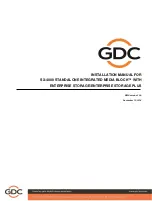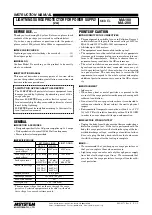
Appendix A
Glossary
013-100199-04
A-1
This appendix defines the specific terms used in this manual as they apply to this projector. Also included are other
general terms commonly used in the projection industry.
The time, inside one horizontal scan line, during which video is generated.
The ability of a screen to reflect ambient light in a direction away from the “line of
best viewing”. Curved screens usually have good ambient light rejection. Flat screens
usually have less ambient light rejection.
The video output of most computers and videotape machines. Analog video can
generate a large number of colors.
Having or requiring a linear distortion, generally in the horizontal direction.
Anamorphic lenses can restore a ‘scope’ (CinemaScope) or ‘flat’ format film frame to
the correct wide-screen appearance by increasing its horizontal proportion.
The American National Standards Institute is the organization that denotes the
measurement standard for lamp brightness.
An Ethernet communication protocol that was developed by Artistic Licence. It is
used for controlling lighting/staging equipment from a lighting console or PC
application.
The ratio of the width of an image to its height, such as the 4:3 aspect ratio common in
video output. Can also be expressed as a decimal number, such as 1.77, 1.85 or 2.39.
The larger the ratio or decimal, the wider and “less square” the image.
The ability of the projector to automatically recognize and synchronize to the
horizontal and vertical scan frequencies of an input signal for proper display.
The frequency range of the projector’s video amplifier.
The speed (bits-per-second) at which serial communications travel from their origin.
The time inside one scan line during which video is not generated. The blanking time
of the input signal must be equal to or greater than the retrace time of the projector.
In projection, brightness usually describes the amount of light emitted from a surface
such as a screen. It is measured in foot-lamberts or candelas per square meter.
Unit of measure for measuring intensity of light.
A collection of measurements stored by the projector for a given input source,
including frequencies, pulse width, polarity, syncs, channel number and location, user-
Active Line Time
f
Ambient
Light Rejection
f
Analog Video
f
Anamorphic
f
ANSI
f
ArtNet Interface
f
Aspect Ratio
f
Auto
Source
f
Bandwidth
f
Baud
Rate
f
Blanking Time
f
Brightness
f
Candela
or
Candle
f
Channel
f
Содержание 1920-DX
Страница 2: ...Downloaded from ProjectorsManual com Manuals ...
Страница 4: ...Downloaded from ProjectorsManual com Manuals ...
Страница 8: ...Downloaded from ProjectorsManual com Manuals ...
Страница 116: ...Downloaded from ProjectorsManual com Manuals ...
Страница 130: ...Downloaded from ProjectorsManual com Manuals ...
Страница 132: ...Downloaded from ProjectorsManual com Manuals ...
Страница 134: ...Downloaded from ProjectorsManual com Manuals ...
Страница 136: ...Appendix D Throw Distance D 2 013 100199 04 SXGA Lenses f Downloaded from ProjectorsManual com Manuals ...
Страница 137: ...Appendix D Throw Distance 013 100199 04 D 3 Downloaded from ProjectorsManual com Manuals ...
Страница 138: ...Appendix D Throw Distance D 4 013 100199 04 Downloaded from ProjectorsManual com Manuals ...
Страница 139: ...Appendix D Throw Distance 013 100199 04 D 5 Downloaded from ProjectorsManual com Manuals ...
Страница 140: ...Appendix D Throw Distance D 6 013 100199 04 Downloaded from ProjectorsManual com Manuals ...
Страница 141: ...Appendix D Throw Distance 013 100199 04 D 7 Downloaded from ProjectorsManual com Manuals ...
Страница 142: ...Appendix D Throw Distance D 8 013 100199 04 Downloaded from ProjectorsManual com Manuals ...
Страница 143: ...Appendix D Throw Distance 013 100199 04 D 9 Downloaded from ProjectorsManual com Manuals ...
Страница 144: ...Appendix D Throw Distance D 10 013 100199 04 Downloaded from ProjectorsManual com Manuals ...
Страница 168: ...Downloaded from ProjectorsManual com Manuals ...
















































